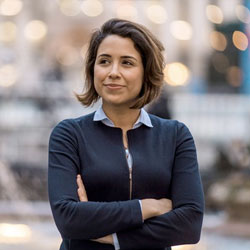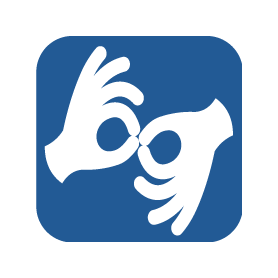LC Interpreting Services is now SignNexus!
CODA, Advocate; Deaf Ally and Proud of It
 In October of 2012, following the Hurricane Sandy press conferences, I was stunned to find YouTube clips of myself interpreting for NYC Mayor Michael Bloomberg spreading across social media. I assure you that becoming a viral video is not something any person can prepare for— it was overwhelming and quite disillusioning. When all was said and done, the biggest lesson I took away from the experience is that mainstream hearing society knows next to nothing about deafness, Deaf culture, American Sign Language, or ASL interpreters. I realized that the media exposure afforded an opportunity to help bring more attention to these topics, and this has been a primary focus of my life ever since.
In October of 2012, following the Hurricane Sandy press conferences, I was stunned to find YouTube clips of myself interpreting for NYC Mayor Michael Bloomberg spreading across social media. I assure you that becoming a viral video is not something any person can prepare for— it was overwhelming and quite disillusioning. When all was said and done, the biggest lesson I took away from the experience is that mainstream hearing society knows next to nothing about deafness, Deaf culture, American Sign Language, or ASL interpreters. I realized that the media exposure afforded an opportunity to help bring more attention to these topics, and this has been a primary focus of my life ever since.
Working in the Deaf community every day, from my years as a staff interpreter at Rochester Institute for the Deaf – National Technical Institute for the Deaf, through to my current position as the owner of a sign language interpreting agency, I’ve witnessed the ongoing fight for deaf rights. I work alongside deaf individuals from all walks of life, in all situations, and see that no one is immune to the struggle against discrimination. I regularly offer pro-bono services for members of the NYC Deaf community, and am active in various organizations including the NTID ASL Interpreter Education Board and the NYC Metro Registry of Interpreters for the Deaf Board. In my day-to-day life, Deaf consumers, colleagues, and friends regularly share their stories. These are the voices I seek to amplify.
By publishing articles on my website, the Huffington Post (where I am an unpaid contributor), and the Buzzfeed Community section (another unpaid venue which anyone can submit to), I strive to bridge the cultural gap that has been so obvious to me for all these years. Through my writing, I aim to educate, entertain, and ultimately raise awareness about deafness and the Deaf community. Blog topics range from ways to support deaf employees, to celebrating Deaf women throughout history, to interviews with successful deaf people working to make their dreams come true. Centering deaf perspectives while reaching hearing audiences is my end goal.
 Not only do I strive to educate through my writing, but also through my company. I work with hearing businesses all the time to help make their organization more culturally competent for deaf employees and customers. LCIS makes the process of securing interpreters comprehensive and we offer literature on working with both deaf individuals and sign language interpreters. By working very closely with deaf consumers, we assess the needs of the individual and help advocate for any accommodations that they feel are necessary. Deaf interpreters are assigned whenever possible and we make sure to educate organizations about their importance. At LCIS, our ASL instructors are Deaf, as are the corporate Cultural Competency trainers, and any ASL coaches who work on film or TV sets that feature deafness or sign language. We could not do any of the work that we do without deaf people!
Not only do I strive to educate through my writing, but also through my company. I work with hearing businesses all the time to help make their organization more culturally competent for deaf employees and customers. LCIS makes the process of securing interpreters comprehensive and we offer literature on working with both deaf individuals and sign language interpreters. By working very closely with deaf consumers, we assess the needs of the individual and help advocate for any accommodations that they feel are necessary. Deaf interpreters are assigned whenever possible and we make sure to educate organizations about their importance. At LCIS, our ASL instructors are Deaf, as are the corporate Cultural Competency trainers, and any ASL coaches who work on film or TV sets that feature deafness or sign language. We could not do any of the work that we do without deaf people!
This is why the New York Times piece that was published this week was highly disappointing. The author offered an audist perspective that I do not endorse. At the time of the interview, I was led to believe the article would focus on discrimination against deaf individuals by highlighting the ways even public entities such as police fail to comply with the Americans with Disabilities Act, thus denying deaf people their legal rights. I referred the author of the piece to several prominent Deaf advocates within the community, and I know of at least one person who was interviewed whose perspective was excluded from the final draft to the detriment of the entire article. I was led to believe the NYT piece would show the vast spectrum of advocacy work that is ongoing in the Deaf community by and for Deaf people. Needless to say, the piece missed its mark.
All I can do is all that I know. I have been fighting for deaf rights alongside my family since I was a little girl. Born and raised in 3 generations of deaf family strong, I was the only hearing person. My mother and siblings all use ASL, my friends use ASL: this is the language of my roots, and the language of my culture. As a CODA (Child of Deaf Adults), I walk a fine line between the deaf and hearing worlds and I spent much of my life wondering where exactly I fit in. Now that I have an opportunity to help promote deaf issues on mainstream platforms, I use these outlets to help raise awareness and fill the cultural gap, and I will continue using them to help make the world a more deaf friendly place.







